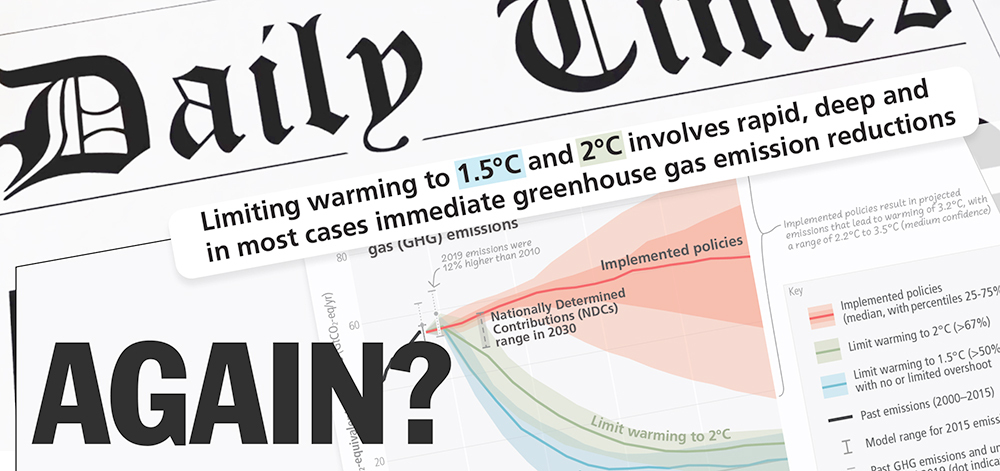My take on the recent IPCC report.
It’s really fascinating to me how much humankind still needs to learn in terms of judging, and more importantly, comparing risks (I think Tversky and Kahnemann (1) came up with enough fun examples around this in the business community). Surely, individual risk behavior doesn’t automatically translate to system-level effects. Too many effects and non-behavioral mechanisms are in play.
That said, the recent IPCC report is just too good of an example of where humanity as a whole is making the same “mistakes” any stranger would in a behavioral lab. We’ve all been essentially looking at the pretty much same graph for the past years. Yet, we’re still overestimating short-term losses compared to long-term gains, looking at the immediate over the permanent, preferring the tactical to the systemic. Humanity continues to systemically address one of the most system-critical challenges on a non-systemic level.
Now, I can’t write another year’s post on “This is the last year, we still have it in our hand” — this has been the core message for the past ten years. The IPCC needs to give a signal of hope and a positive message of course. And it should, there is indeed a lot of opportunity, still. That said, saying year after year that if we just started now, we would make it work, is something I personally can no longer trust to make the difference.
Hence, my takeaway from IPCC’s recent report is different, maybe a bit more somber:
- We have, in the past, underestimated the amplitude of negative effects: The materializing impact of the current 1.1-degree reality is worse than anticipated a few years ago for that temperature. Hence, we can expect that the 1.5- and 2.0-degree pathways will actually be even less of a joyride than many make them to be. In essence, we are learning that the targets that we are consistently failing to achieve might not really be ambitious enough. There is a lot of damage that is essentially already done but not yet “felt”, I don’t think many are aware of it.
- NDCs are cute but won’t help if no one delivers: Currently implemented policy is continuing to lead to CO₂ increases every single year. We should have been reducing net emissions for a while now. We’re still doing the opposite. The planned scenarios are not sufficient for any target, and most of policy is not yet put into motion. From my personal discussions with policymakers and politicians across Europe and the US I am not 100% sure the immediacy has arrived in administration yet, nor that there are sufficient concrete and practical plans in place. Climate change is complicated and policy is equally complicated. Countries, governments, agencies need to build expertise and try out new ways to get there. Policy needs to step up quickly — but clearly won’t solve this alone.
- There are ways, but nobody walks them: While the IPCC did outline seemingly feasible measures to turn the ship around, I do not share their optimism that these are realistically currently feasible. Getting to the current set of targets and the already running decarbonization measures took 20+ years of extreme effort. Not only did we not turn around the ship, but we are still going full-steam in the wrong direction. Permanent removals are an important part but not enough in terms of volume and speed to impact. Scalable access to renewable energy and large scale ecosystem protection (via climate finance or otherwise) is equally required. While investment and commitments have stayed, we still look at maybe 10 globally significant carbon removal deals, and a yet nascent carbon market (compared to other industries). Adoption will need to rise (ideally with the help of policy) immediately.
We need to do everything, immediately, all of us. Policy is an important part of the component but is failing in delivery. Companies need to go beyond regulation (many are starting to) immediately but lack both tools and backing for their activities.
In parallel to decarbonizing the global industrial sector (which just takes time), we need to come up with effective mitigation tools that can compensate for the slow conversion of many expensive real assets to serve a more climate-friendly purpose. The time for either/or has long gone.
What helps individuals improve risky decisions? Looking at data, rationalizing risks, following heuristic protocols, and breaking down long, complex decision processes into smaller, fixed, and manageable steps. Again, complex systems don’t work like individuals. But may the (esoteric) comparison be allowed in this case: Much like individuals, we need to do the many small things and big things, every day, and find the way out step by step. It’ll be expensive. It’ll hurt. It won’t be glamorous (by current standards). But whatever we can do marginally is worth the effort. With simplified protocols, doing what we know works immediately, trying out what we think works at the same time, and measuring every step of the way. So let’s go. Until it’s the last call, again, next year!
(1) While Prospect Theory has been widely popularized and served many business and economics students like myself great examples of intuitively understandable decision fallacies and inaccuracies, it is important to note its limited applicability in the field. It’s used as an allegory here, but for people interested, there is a nice review of Barberis (2013) for example.
To learn more about CEEZER, please get in touch or book a demo today.





